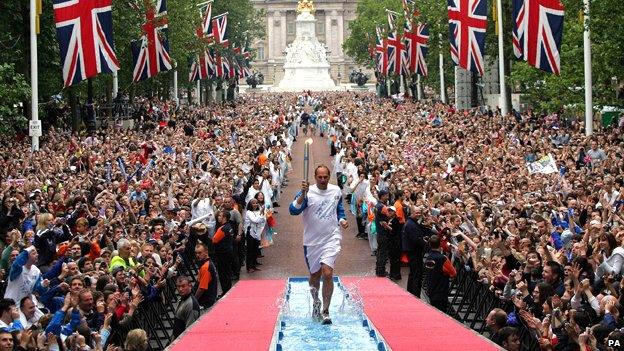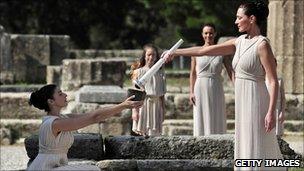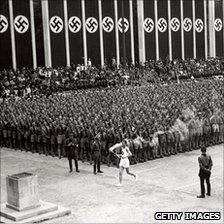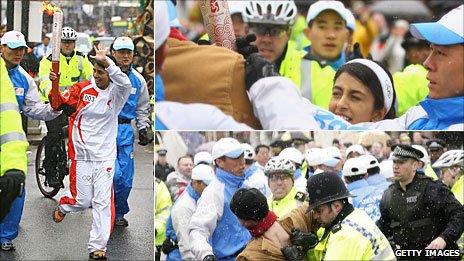London 2012: What is the Olympic torch relay?
- Published

An Olympic torch relay will tour the UK for 70 days ahead of the London 2012 Olympic Games. So what is this relay, and why all the fuss?
"It is an utterly thrilling thing to do," says Philip Barker.
The Olympic historian and author has a lump in the throat just at the memory of running, torch clasped in his hand, high in the Taygetos mountains above Sparta, Greece.
He was a part of the torch relay, the human-powered running feat that bore the flame in 1996 on its journey from its source, Olympia, to the Atlanta Games.
From 19 May 2012, the Olympic torch relay will tour the UK in the run-up to the London Games - taking 70 days, carried by 8,000 torchbearers.
Organisers say 95% of the country's population should be within one hour of the route, which ends on 27 July with the lighting of the cauldron during the opening ceremony in the Olympic Stadium, Stratford.
Locog hopes that the emotion felt by Philip Barker will be shared by the nation, among crowds lining the route.
But how did the Olympic Games come to have this almost cultish following of a naked flame?
The perception of the torch relay is that it's a contemporary re-enactment of an ancient Greek tradition.
In reality, it is a phenomenon just of the modern Olympics, only beginning in the 1936 Summer Games in Berlin, and for the Winter Games at Oslo in 1952.
But the idea is rooted in a mash-up of Greek myths, thought to date from around the 6th-5th centuries BC.

The flame is kindled from sunlight - with back up flames lit on previous days in case it is cloudy
The stories concern Prometheus. He was a Titan and "friend to man" who stole fire, a sacred element, disguised inside a narthex stalk (a kind of giant fennel) from Zeus, the father of the Gods, and gave it to mortals.
The ancient Greeks had Lampadedromia - torch relay races - where the winning team lit a sacred flame, possibly as part of the cult worship of Prometheus and his defiance of the gods to impart knowledge to mortals.
The modern relay has a nod to the flame-kindling vestal virgins from the rival Roman civilisation thrown in.
It also conjures the spirit of the "sacred truce", a peace declared across ancient Greece in the months before an Olympic Games and communicated by runners who travelled the country.
As University of Oxford classicist Cressida Ryan puts it: "It's an amalgam of bits of mythology.
"Agreeing on the facts doesn't really matter, it's too long ago to know. Today it is used as a force for good - someone has taken an idea and run with it."

The relay tradition began at the Berlin Games in 1936
An Olympic flame first burned at the 1928 Amsterdam Games but it was not until 1936 that a relay with a torch took shape, under the Nazi regime and sports organiser Carl Diem.
A flame was kindled in Olympia using the sun and a parabolic mirror, then carried to the Berlin stadium by runners through Bulgaria, Yugoslavia, Hungary, Austria and Czechoslovakia - countries that later would fall under Nazi domination.
Fire was a symbol of Hitler's regime, and torchlight processions were a feature. The leadership aimed to draw a direct link back to ancient civilisation. As Ryan explains: "They wanted a symbolic bridge between ancient Greece and modern Germany. And light is a symbol of purity - the bright, white, pure, stunning light of the ancient Greeks was something that fed into the Aryan myth."
Adolf Hitler's favoured filmmaker Leni Riefenstahl captured that myth, documenting the event for her 1938 film Olympia.
Post-war, for the 1948 London Olympics, organisers embraced the idea of the torch relay. Despite the austere times, the torch was mobbed by crowds along the route.
Since then, the torch has enjoyed <link> <caption>a mostly high old time</caption> <altText>IOC Olympic Torch fact sheet</altText> <url href="http://www.olympic.org/Documents/Reference_documents_Factsheets/The_Olympic_Torch_relay.pdf#page=2" platform="highweb"/> </link> , every four, and latterly two, years, <link> <caption>changing design with each Olympic host city and each decade's trends</caption> <altText>Torch timeline</altText> <url href="http://www.bbc.co.uk/news/uk-13424048" platform="highweb"/> </link> .
The relay has sometimes gone with a theme - Rome 1960: The Ancient Relay; Mexico City '68: The Relay to the New World; Seoul '88: Harmony and Progress.
The modes of transportation have become ever-more outlandish - on skis, Oslo 1952; Skidoo, Calgary '88; and ski-jumper, Lillehammer '94.
The torch has taken to the water with swimmers, in Veracruz, Mexico '68 and in Marseilles, France for Grenoble '68 as well as under water at the Great Barrier Reef for Sydney 2000.
It has taken to the skies - on Concorde, Albertville '92; via satellite, Montreal '76; parachute, Lillehammer '94. And the torch, without flame, has been into space, twice, ahead of Atlanta '96 and Sydney 2000.
Canoes, steamboats, wagons, horses, camels and many sportspeople and celebrities have also played their part.

The Beijing 2008 global relay was the most ambitious - 21,800 torchbearers, 137,000km, 129 days. But it met frequent and sometimes violent protest
It has also drawn protest, most prominently from pro-Tibet and human rights campaigners in many countries when it was flanked by Chinese bodyguards in its round-the-world-tour ahead of Beijing 2008.
And until at least the 1950s, it was rather a sexist torch - no women were allowed to take part.
The flame is sometimes accidentally extinguished en route, apparently "more often than they like to let on," says Barker.
In case of such an event, it can be re-lit with special back-up flames from Olympia carried with the relay, often in miners'-style lamps.
Should a cloudy day threaten the initial ceremony when women kindle the flame from the Sun at Olympia, there are also a series of flames kept in reserve from the "practice kindles" in the days leading up to the televised event.

The torch has been used to light the cauldron by sporting legends like Muhammad Ali, by athlete Li Ning suspended on wires, by paralympic archer Antonio Rebollo and as fire amid water by runner Cathy Freeman
It is all part of the facade that Olympic-minded historians say stokes enthusiasm for a positive sporting event, often among people who cannot be at the Games themselves.
The founder of the modern Olympic movement, Pierre de Coubertin hoped the Olympic torch would "pursue its way through ages, increasing friendly understanding among nations, for the good of a humanity always more enthusiastic, more courageous and more pure."
Thirty Olympiads on, for carriers like Barker, that symbolism is key.
"When it is your turn to carry the flame, you think emotional thoughts, think of people who have competed in the Olympics, Jesse Owens, great heroes like Steve Redgrave," he says.
"You feel part of that because you're helping take the flame to the stadium. It was extremely special, very emotional."